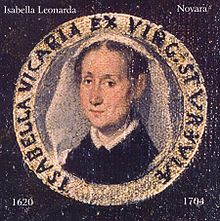Nun and Baroque Composer

Among the most famous musicians of early modern Lombardy were its cloistered nuns, despite the efforts of church officials to limit their musical lives. In Celestial sirens : nuns and their music in early modern Milan, Robert L. Kendrick (Oxford, 1996) details the cultural context, religious traditions, musical styles, and personal meaning of the music written by and for them from the late sixteenth to the early eighteenth century on the basis of massive archival documentation.
In various ways their status as female virgins was–and was not–central to the musical expression of their piety. The music actually composed by these nuns reveals the musical expression of women’s devotional life. The two centuries’ worth of battles over nuns’ singing of polyphony also suggest that the implementation of reform in a major center of post-Tridentine Catholic renewal was subject to local political pressure and individual interpretation. Other factors – liturgical traditions of the religious orders, the problems of performance practice attendant upon all-female singing ensembles- marked nuns’ musical lives and creative output.
Nuns originated in this world but dwelt on the threshold of the next. The music composed in female monasteries was sacred yet shaped by secular trends as well as by tradition and canon. The terrestrial influence on the celestial sirens made their performances very popular, but this also brought them into conflict with bishops who sought to reinforce the wall between cloister and community. In the mind of the laity the nuns-their sisters, aunts, daughters-remained “sacred virgins with a public role” and their musical talents were civic treasures enjoyed by many and remarked upon by visitors.
Highly personalized and emotive treatment of old texts and the introduction of dialogue highlighted the values guiding their lives. Simplicity, clarity, and strictly choral singing gave way to polyphonic complexity and vocal virtuosity whose very novelty drew appreciative audiences. It was music by and for women, appropriate in text and vocal ranges, whose fame spread beyond the walls that entombed them; indeed, the white martyrdom of the professed nun was a subject celebrated musically.
Anna Isabella Leonarda (6 September 1620 – 25 February 1704) was an Italian composer from Novara. At the age of 16 she entered an Ursuline convent. Leonarda is most renowned for the numerous compositions that she created during her time at the convent, making her one of the most productive woman composers of her time. She was the daughter of Giannantonio Leonardi and his wife, Apollonia. The Leonardi were an old and prominent Novarese family whose members included important church and civic officials and knights palatine. Isabella’s father, who held the title of count, was a doctor of laws.
In 1636, Leonarda entered the Collegio di Sant’Orsola, where she stayed for the remainder of her life. Her family maintained close ties with Sant’Orsola as benefactors, which some speculate may have contributed to Leonarda’s influence within the convent. She held various positions of authority throughout her time at Sant’Orsola – as madre (1676), superiora (1686), madre vicaria (1693), and consigliera (1700). The precise significance of these titles is unclear, but superiora was probably the highest office in the convent. She was also identified in documents as magistra musicae (music teacher). It seems from this that Leonarda played some role within the convent teaching the other nuns to perform music. This may have also afforded her opportunities for the performance of her works by the convent’s nuns.
Not much is known about Leonarda’s musical education before entering Sant’Orsola, though many speculate that she may have had some such education due to the high social and economic status of her family. It has also been suggested that once in the convent, she studied with Gasparo Casati (1610–1641), a talented but little-known composer who was maestro di cappella at the Novara cathedral from 1635 until his death. The only direct evidence linking the two, however, is Casati’s Terzo libro di sacri concenti (Milan, 1640), which contains two dramatic dialogues, the earliest known compositions of Leonarda.
While Leonarda was a highly regarded composer in her home city, she was apparently little known in other parts of Italy. Her published compositions span a period of 60 years, beginning with the dialogues of 1640 and concluding with the Motetti a voce sola of 1700. Leonarda is credited with producing nearly two hundred compositions during that period. Her only works appearing before 1670 were the dialogues printed by Gasparo Casati. It appears that she was over the age of 50 before she started composing regularly, and it was at that time that she began publishing the works that we know her for today. Not much is known about her involvement as a singer or instrumentalist but she was one of the most prolific convent composers of the Baroque era.
Leonarda’s works include examples of nearly every sacred genre: motets and sacred concertos for one to four voices, sacred Latin dialogues, psalm settings, responsories, Magnificats, litanies, masses, and sonata da chiesa. She also wrote a few sacred solo songs with vernacular texts. The intricate use of harmonies is one example of her influence in the cultivation of polyphonic music at Sant’Orsola, as many other Italian nun composers were doing at their own convents during the same period. This style created an atmosphere conducive to the creativity of the musician, allowing for slight improvisation or musical ornamentation.
Almost all of Leonarda’s works carry a double dedication – one to the Virgin Mary as well as one to a highly placed living person. In one of her dedications, Leonarda stated that she wrote music not to gain credit in the world, but so that all would know that she was devoted to the Virgin Mary. The living dedicatees include the archbishop of Milan, the bishop of Novara, and Emperor Leopold I. The need to seek financial support for the convent likely motivated many of these dedications. She also noted in the dedication to Opus 10 that she wrote music only during time allotted for rest so as not to neglect her administrative duties within the convent. This contradicts many speculations that Leonarda was able to spend more time composing than other nuns of the time due to her positions of authority within the convent.
A setting of Ave Regina Caelorum by Suor Isabella Leonardo will be performed at the WSMP Interfaith Community Concert on December 1st. This setting in g minor was published in her Motetti a quattro voci (Milan: Camagni, 1684). The printed part books for mixed voices (SATB) and continuo are the sole source. This setting was probably intended for performance during Mass. It betrays the influence of contemporary dance music in its sprightly 6/8 meter and upbeat conclusion. Expressive use is made of melisma on the words exora pro nobis (pray for us), of tutti and soli passages, of dynamic contrast for an echo effect and of brief points of imitation. These distinctly contemporary techniques are layered with a degree of skill to express the joyous character of the text.
The use of only women’s voices raises interesting questions about performance practice in Baroque convents. If this work was conceived for use by the sisters at Sant’Orsola, the mixed-voice setting may represent an adaption for publication. The printed volumes were intended for the general market of choirs of men and boys. Candace Smith has proposed that the lower parts in the printed editions be transposed to treble range for performance solely by women’s voices. The bass line may be reinforced in the original register by organ or other instruments. Evidence exists that despite a ban on the use of instruments in convents, the Lombard nuns played trombones, an excellent choice for the lower voices. Here it is performed on Youtube by the Cappella Artemisia. http://www.youtube.com/watch?v=wCBFWNrfiJY
